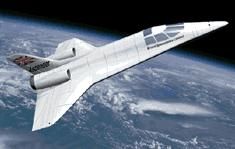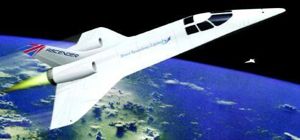
Home - Search - Browse - Alphabetic Index: 0- 1- 2- 3- 4- 5- 6- 7- 8- 9
A- B- C- D- E- F- G- H- I- J- K- L- M- N- O- P- Q- R- S- T- U- V- W- X- Y- Z
Ascender
 Ascender |
Status: Design 1992.
The Ascender spaceplane would use a small Viper turbojet engine as well as a main liquid fuel rocket engine. The Ascender would act as a technology demonstrator for the orbiter of the orbital Spacecab concept.
Ascender was designed to be the first sub-orbital airplane since the X-15, and the first ever to carry passengers to space. During the air-breathing phase of flight, Ascender would be powered by two Williams -Rolls FJ44 turbojets, each rated at a takeoff thrust 860 kgf. The rocket engine would be a Pratt & Whitney RL10, using hydrogen and liquid oxygen and delivering approximately 9,000 kgf of thrust. Ascender would carry a crew of two and two passengers (or other payload) to space and back. Passengers would experience two minutes of weightlessness. Ascender would take off from an ordinary airfield using its turbofan engine and climb at subsonic speed to a height of 8 km. The pilot then would start the rocket engine and pull up into a steep climb. When the rocket fuel was used up Ascender would be climbing close to the vertical at a speed of Mach 2.8, from which it would coast to a maximum height of 100 km. Ascender would then enter a steep dive. On reaching the atmosphere the pilot would pull out of the dive and fly back to the airfield from which he took off 30 minutes previously.
Crew Size: 4.
Family: European Rocketplanes, Rocketplane, Winged. Country: UK. Agency: Bristol Spaceplanes.
 | Ascender |
Back to top of page
Home - Search - Browse - Alphabetic Index: 0- 1- 2- 3- 4- 5- 6- 7- 8- 9
A- B- C- D- E- F- G- H- I- J- K- L- M- N- O- P- Q- R- S- T- U- V- W- X- Y- Z
© 1997-2019 Mark Wade - Contact
© / Conditions for Use